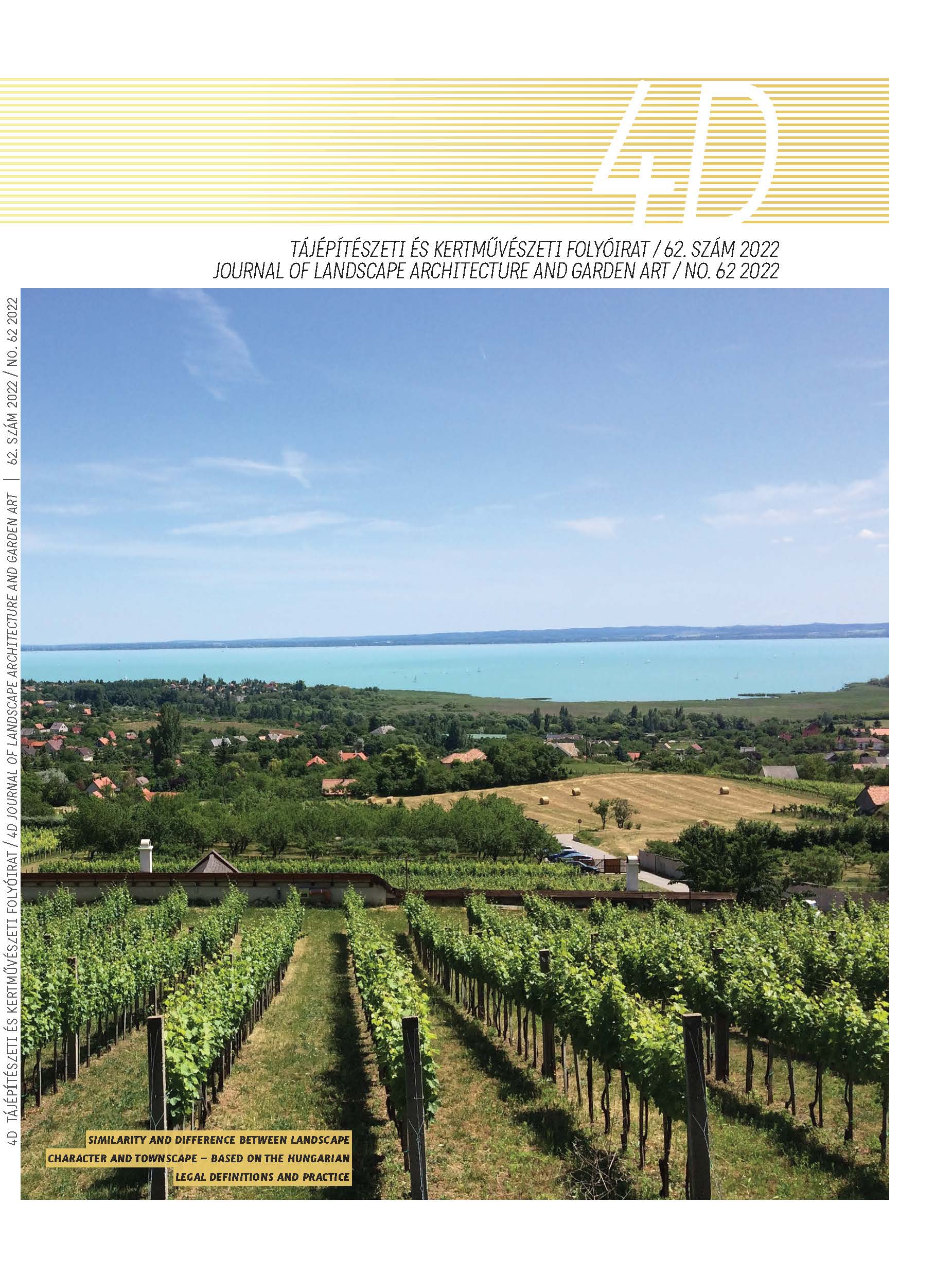Sustainable Grassland Management in Historic Gardens
Methodology and Basics
DOI:
https://doi.org/10.36249/62.4Kulcsszavak:
történeti kert, gyepfenntartásAbsztrakt
The possibilities for research and restoration of the often damaged and fragmented historic gardens in Hungary were relatively limited in the past, but thanks to the funds provided by the European Union, more than 20 gardens were reconstructed between 2007 and 2013. Since then 18 further sites had the chance for partial restoration (covering at least the surroundings of the mansions) in the framework of the National Mansion and Castle Programme. Historic gardens have an outstanding importance in terms of heritage conservation, tourism potential and the promotion of historic garden heritage for the public. However, as a result of the restorations carried out, the extent of the areas requiring long-term maintenance has increased, which can be a challenge for the garden managers. Nowadays, the role of our landscape gardens has changed significantly, and because of this, their long-term management requires adequate preparation established on a scientific basis. The restoration process requires the integration of several different approaches from different disciplines. This complexity of approaches, appears accordingly in the case of garden management, so first we have to find the suitable framework for sustainable management and maintenance. In order to achieve this, we must synthesise the accumulated knowledge of the current management regime, which is the most important part of this complex duty. Based on previously published experiences, the main task of conservation is clearly the restoration of the spatial layout. This means that garden areas that have been neglected and afforested over the last decades, must be cleared of the overgrowth, thereby revealing the visual structure of the gardens. From practical point of view, and also regarding the fundamental concept that regards gardens as living, plant-based creations, it is obvious that constant management and maintenance is essential in the conservation of the garden heritage.
Based on the experience of daily practice, and Hungarian literature on green space management and maintenance, it is clear that the conservation of the garden heritage is currently based on horticultural approach and technologies. Works of this kind, regardless of their intensity, usually appear in the management budget as a surplus expenditure. Following the restoration works, garden areas that have to be maintained expand, thus the resources for maintenance tasks need to be increased as well. This fact puts the management in a difficult situation, because with a usually tight budget, when maintenance work cannot be carried out as necessary, the heritage assets might again deteriorate and the restoration work go to waste. Solving this problem is a huge practical challenge. In order to develop a widely applicable solution, a proper scientific basis can be very useful. Therefore, the authors' collaborative research is aimed to find landscape solutions for heritage protection by sustainable maintenance. This article introduces the basic methodology of the topic.
In order to examine the methods of the so-called sustainable conservation management of historic gardens, which is the aim of the research, it is necessary to analyse the basic materials of the study. Due to the variety of historic garden styles and the different management requirements related, the research is limited to English gardens located in the historical territory of Hungary. One of the reasons for the specific focus of the study is the typology of Hungarian historic gardens. The majority of our historic gardens are remains of English style gardens, so the results will be widely applicable to develop practical solutions. Another important reason is the main concept of English gardens: these aim to create idealised landscapes, where humanity and nature can co-exist in harmony. English landscape gardens seem to us to be optimal models for investigating the issue of sustainable garden management, since the idealised landscape of the 19th century can be characterised by proximity to nature, once based on naturally applied, nowadays so-called, ecological principles, to which the human activity is added. Moreover, besides the economical and ecological aspects, the artistic factor of the gardens is a further main element as a result of social need. These components of sustainability clearly appear in the ideology of designed landscapes. After defining the material of the research, we had to study the restoration processes. As mentioned earlier, conclusions can be drawn from experiences of restoration practices. One of the most significant goals is the restoration of the spatial layout: to define and restore the ratio of historical grasslands and woodlands, and the original composition transforming the neglected site.
That is why the research focuses on gardens with recently restored spatial layout or with the spatial layout well preserved. After reviewing the relevant research materials, and in order to define the garden's sustainable management regime, we had to develop a methodology first. We had to define where to start the work in order to find answers to the following questions: What can be considered as heritage feature in a garden? How can we define the levels of maintenance intensity required for different parts of a garden?
Which are the parts of a garden where sustainable technologies can be applied?
This paper describes a methodology in development, which can be a basis to find answers to these questions. The methodology will be presented through a site analysis and the evaluation of the research approach. The site which has been chosen for this study is the park of Andrássy Mansion in Betliar, Slovakia. The park remained in a good state of repair, although further reconstructions are needed. With its current spatial layout it is suitable for introducing our methodology.
Hivatkozások
Alföldy G. (2013): Történeti kertek a változás közelében. Műemlékvédelem 57 (6), 385-399.
Alföldy G. (2015): A dégi Festetics-kastélypark. Forster Központ: Budapest.
Bálint K. (2020): A gyömrői Teleki-kastély parkjának története a kezelés tükrében. In: Fodor M. – Bodor P. (ed.): SZIEntific meeting for young researchers, Szent István Egyetem: Gödöllő, pp. 81-92.
Báthoryné Nagy I. – Gergely, A. – Bálint, K. (2019): Fenntartható és klímaadaptív városi gyepfenntartás Veszprém közterületein (2016-18) és annak hatása a gyepek diverzitására. In: Fazekas I. – Lázár. I. (ed.): Tájak működése és arculata. MTA DTB Földtudományi Szakbizottság: Debrecen, pp. 337-342.
Buttlar, A. (1989): Der Landschaftsgarten Gartenkunst des Klassizismus un der Romantik. DuMont: Köln.
Google Earth satellite imagery, 2009 (2021.01.20.)
Google Earth satellite imagery, 2021 (2021.01.20.)
ICOMOS (1982): The Florence Charter. Article 1.: ICOMOS Florence [online] In: ICOMOS. URL: https://www.icomos.org/en/what-we-do/focus/179-articles-en-francais/ [2021. június 06.]
Jámbor I. (2019): Nebbien Városligete : a világ első népkertje Pesten. Terc: Budapest.
KEOP-3.1.3./2F/09-11 EU-2007-2013. [online] In: URL: PALYAZAT.GOV.HU. https://www.palyazat.gov.hu/tamogatott_projektkereso [2021.01.20.]
Kiácz Gy. – Szendrői J. (1980): A zöldfelületek fenntartása. Mezőgazda Kiadó: Budapest.
Konijnendijk, C. (2012): Between fascination and fear – The impacts of urban wilderness on human health and wellbeing. Socialmedicinsk tidskrift. (3), 289-295.
Kozák L. (2012): Természetvédelmi élőhelykezelés. Mezőgazda Kiadó: Budapest.
Ormos I. (1955): A kerttervezés története és gyakorlata. Mezőgazda Kiadó: Budapest.
Orthophoto (2020) [online] In: Geoportál. URL: https://www.geoportal.sk/en/ [június 06.]
Szikra É. (2000): A tájképi kertek rekonstrukciós, helyreállítási lehetőségei és módszerei. In: Galavics G. (ed.): Történeti kertek : Kertművészet és műemlékvédelem. MTA Művtört. Kut. Int.: Budapest, pp. 116-126.
Takács K. (2017): Uradalmi kertészetek a 19. századi Magyarországon. [PhD értekezés]. Szent István Egyetem, Tájépítészeti és Tájökológiai Doktori Iskola, Budapest. DOI: http://doi.org/10.14751/SZIE.2017.050
Török P. – Tóthmérész B. (2015): Ökológiai szemléletű gyeptelepítés elmélete és gyakorlata. Ökológiai Mezőgazdasági Kutatóintézet: Budapest.
Watkins, J. – Wright, T. (2007): The management and maintenance of historic parks, gardens and landscapes : The English heritage handbook. Lincoln: London.
Letöltések
Megjelent
Folyóirat szám
Rovat
License
Copyright (c) 2022 Báthoryné Nagy Ildikó Réka, Bálint Krisztina

This work is licensed under a Creative Commons Attribution-NonCommercial-NoDerivatives 4.0 International License.
A folyóirat Open Access (Gold). Cikkeire a Creative Commons 4.0 standard licenc alábbi típusa vonatkozik: CC-BY-NC-ND-4.0. Ennek értelmében a mű szabadon másolható, terjeszthető, bemutatható és előadható, azonban nem használható fel kereskedelmi célokra (NC), továbbá nem módosítható és nem készíthető belőle átdolgozás, származékos mű (ND). A licenc alapján a szerző vagy a jogosult által meghatározott módon fel kell tüntetni a szerző nevét és a szerzői mű címét (BY).









 intézetigazgató: Dr. Fekete Albert
intézetigazgató: Dr. Fekete Albert

